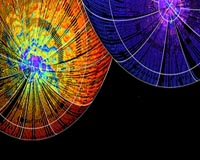 |
Potsdam, Germany (SPX) Sep 22, 2009 Over its ten months of operation, the Chandrayaan-1 X-ray Spectrometer (C1XS) has gathered data for a total of 30 solar flares, giving the most accurate measurements to date of magnesium, aluminum, silicon, calcium, and iron in the lunar surface. Results will be presented at the European Planetary Science Congress in Potsdam, Germany, by the instrument's Principal Investigator, Professor Manuel Grande. Although contact was lost with Chandrayaan-1 last month, the enhanced performance of the C1XS instrument, which exceeded its design specification, means that the science team will be able to determine the geochemistry of new areas of the lunar surface, adding some vital pieces to the jigsaw of the mineralogy of the lunar surface. The miniature C1XS instrument investigated the lunar surface using an effect whereby X-ray illumination from the Sun causes rocks to fluoresce, emitting light at a different wavelength. This re-emitted light contains spectral peaks that are characteristic of elements contained in the rock, revealing its composition. Solar flares act like a flash bulb, giving added illumination and allowing C1XS to 'see' more elements. During normal conditions, C1XS could detect magnesium, aluminum, and silicon and collected data on the levels of these elements, enabling detailed mapping of areas of the lunar surface during its operational period. During the 30 solar flares, C1XS detected calcium and iron (and sometimes titanium, sodium, and potassium) in key areas in the southern hemisphere and on the far side of the Moon. The spectral resolution of 50 km was much better than previous missions. "The C1XS team will be analyzing the data collected during the Chandrayaan-1 mission over the next few months, and the results will help us further our knowledge of the Moon and planetary formation. In addition, the design of the instrument has been proved very successful in that it withstood passage through the Earth's radiation belts and went on to produce these wonderful high-resolution spectra. We were able to separate clear peaks for each of the target elements, allowing us not only to identify where they are present but give an accurate estimate for how much is there. The technology developed for C1XS opens up some exciting opportunities for future missions," said Professor Grande. Share This Article With Planet Earth
Related Links - Mars News and Information at MarsDaily.com Lunar Dreams and more
 NASA Lunar Satellite Begins Detailed Mapping Of Moon's South Pole
NASA Lunar Satellite Begins Detailed Mapping Of Moon's South PoleGreenbelt MD (SPX) Sep 18, 2009 NASA reported Thursday that its Lunar Reconnaissance Orbiter, or LRO, has successfully completed its testing and calibration phase and entered its mapping orbit of the moon. The spacecraft already has made significant progress toward creating the most detailed atlas of the moon's south pole to date. Scientists released preliminary images and data from LRO's seven instruments. "The LRO ... read more |
|
| The content herein, unless otherwise known to be public domain, are Copyright 1995-2009 - SpaceDaily. AFP and UPI Wire Stories are copyright Agence France-Presse and United Press International. ESA Portal Reports are copyright European Space Agency. All NASA sourced material is public domain. Additional copyrights may apply in whole or part to other bona fide parties. Advertising does not imply endorsement,agreement or approval of any opinions, statements or information provided by SpaceDaily on any Web page published or hosted by SpaceDaily. Privacy Statement |